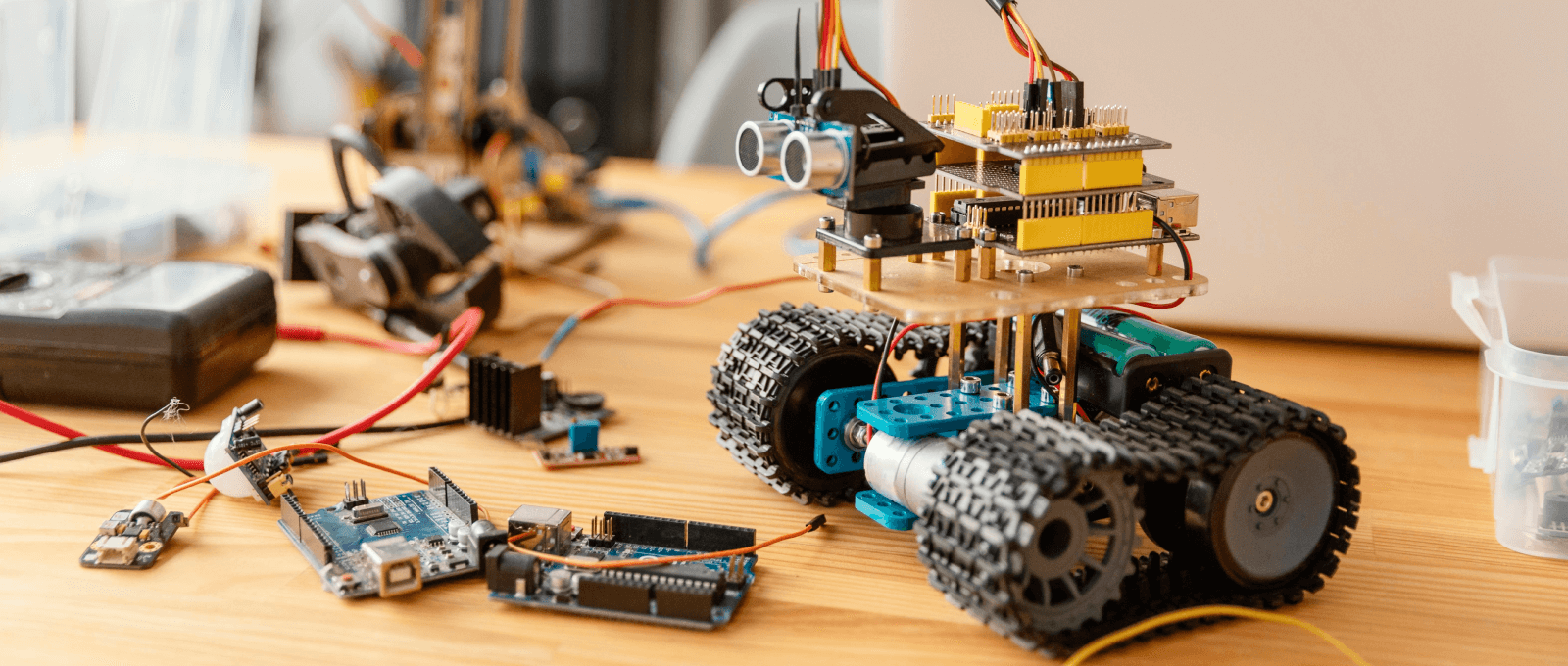Robots have become integral to our modern world, revolutionizing various industries and transforming our lives and work. Over 4.28 million industrial robots are operating in factories worldwide, highlighting just how widespread automation has become. Robotics solution have found their place in diverse fields, from manufacturing and healthcare to space exploration and entertainment. These popular robots have evolved into diverse forms designed to fulfill specific tasks and operate in various environments.
The different types of robots arise from the need to optimize different industries and their unique work requirements. Each category has numerous variations, with robots differing in shapes, sizes, and even the number of legs they possess, whether two, six, or eight.
Today, many robots can be controlled and monitored through mobile applications, making it easier for users to manage robotic systems remotely. Frameworks like React Native make it possible to develop high-performance, cross-platform apps that provide seamless control and real-time data for these robots.
Despite differences, all types of robots share common components and technologies. So read on, and let’s collectively explore these various types of robots, highlighting the fascinating world of robotics and its wide-ranging applications.
Key Takeaways
- Robots now play a vital role across industries such as manufacturing, healthcare, agriculture, defense, retail, and space exploration, helping optimize processes, improve safety, and enhance efficiency.
- The blog covers 30 types of robots, including industrial, domestic, drones, humanoids, exoskeletons, warehouse robots, nanorobots, and RPA bots, each serving unique purposes from precision surgery and farming automation to disaster response and customer interaction.
- Most robots share common technologies like sensors, AI, mobility systems, and remote-control apps, which allow them to operate autonomously, collaboratively, or under human supervision.
- With ongoing progress in AI and machine learning, robots are becoming more advanced and accessible, promising greater innovation, efficiency, and safety across diverse applications.
30 Different Types of Robots
The following are the 30 different types of robots we are going to discuss.
1. Industrial Robots
Industrial robots are most specifically designed and programmed to perform various tasks in manufacturing and assembly lines. These types of robots are extensively used in the automotive, electronics, and pharmaceutical industries to automate repetitive and labor-intensive processes.
Industrial robots excel at tasks like welding, where they can consistently and accurately join metal components, ensuring high-quality welds. And in painting applications, this field of robotics results in a superior finish. By doing these repetitive tasks, industrial robots improve productivity and allow workers to focus on more complex and value-added activities.
Industrial robots can also be classified by design:
- Articulated Robots: Because of their flexible and extremely adaptable design and rotating joints, these robots can be used for complicated assembling, welding, and material handling operations.
- SCARA Robots: Short for Selective Compliance Articulated Robot Arm, SCARA robots are designed for speed and precision, commonly used for pick-and-place, assembly, and packaging operations.
- Cartesian Robots: Also known as gantry robots, they operate along the X, Y, and Z axes, providing high accuracy and strength. They are widely used in CNC machining, 3D printing, and applications requiring linear motion.
2. Domestic Robots
Domestic robots are one of the most commonly used types of robots, designed to assist with household chores, providing convenience and efficiency in daily tasks. One common type of domestic robot is the robot vacuum cleaner, which autonomously cleans floors and carpets, eliminating the need for manual vacuuming. These robots use sensors and navigation algorithms to navigate around furniture and obstacles, ensuring a thorough cleaning.
These domestic robots save time and effort, allowing individuals to focus on other activities while their household chores are taken care of.
3. Medical Robots
Medical robots are robotic systems that assist in various medical procedures, including surgery, rehabilitation, diagnostics, and patient care. Various types of robots are available that offer precise and controlled movements, aiding surgeons in complex surgeries with improved accuracy and minimal invasiveness. Examples of medical robots include surgical robots like the da Vinci Surgical System.
4. Social Robots
Social robots are specifically created to engage in social interactions with humans by following social norms and behavior. Unlike other types of robots, these specific robots can engage in conversations, offer reminders, and even play games. Social robots help bridge the gap between humans and technology, enhancing our well-being and offering new avenues for engagement and interaction. This is a type of robot that helps humans by engaging them in meaningful conversations through advanced AI and machine learning that perceives emotions and understands human language.
5. Mobile Robots
Mobile robots are versatile types of robots that can move and navigate in various environments. They can be classified based on wheeled, tracked, and legged locomotion capabilities. Mobile robots are becoming increasingly popular as they can perform dangerous or difficult tasks for humans. These mobile robots open many possibilities for industries and research, facilitating efficient movement and exploration in diverse settings. In this field of robotics, the system uses sensors and software to recognize its surroundings, make decisions, and perform tasks with absolute efficiency and accuracy.
6. Drones
Drones are robotic systems capable of flying and maneuvering in the air. Equipped with cameras, sensors, and GPS systems, drone robots can capture aerial images and videos, perform aerial surveys, and even deliver packages. Drones provide efficient AI in robotics solutions for tasks that would otherwise be difficult or dangerous for humans.
With technological advancements, drone robots are becoming increasingly sophisticated, offering longer flight times, improved stability, and enhanced autonomy, opening up new possibilities for industries and recreational use.
7. Cobots
Cobots, short for collaborative robots, work alongside humans in a shared workspace, fostering collaboration and cooperation. These robotics in AI are typically smaller and lighter than traditional industrial robots and are built with safety features and sensors that allow them to operate safely in close proximity to humans. They are used in manufacturing, healthcare, and logistics industries to enhance productivity and contribute to more efficient and flexible production processes.
8. Autonomous Robots
Autonomous robots perform tasks without human intervention. They are typically equipped with sensors, actuators, and software that allow them to perceive their environment, plan their actions, and execute those actions. The evolutions in artificial intelligence (AI) and machine learning (ML) continue to drive the development of more capable and versatile types of robots. Self-driving cars are a common example of autonomous robots.
9. Educational Robots
Educational robots are designed to teach and engage students in interactive learning. These robotics applications can be programmed for hands-on learning in schools and educational institutions. Robotic toys and STEM kits are designed to introduce children to robotics and coding concepts playfully and educationally.
10. Humanoid Robots
Humanoid robots are designed to resemble and mimic human appearance and behavior to a certain extent. These AI in robotics solutions are built with a human body structure, including a head, torso, arms, and legs, which allows them to interact with humans more familiarly and naturally.
For example, Atlas is a humanoid robot developed by Boston Dynamics. It is designed for search and rescue operations, capable of walking, running, and climbing stairs.
11. Entertainment Robots
Entertainment robots are designed to provide amusement and entertainment. They can take various forms, from different types of humanoid robots capable of interacting with people through conversation and gestures to robotic toys designed for playful interactions. Entertainment robots often incorporate advanced technologies such as artificial intelligence, voice recognition, and facial recognition to create immersive and interactive experiences. They can perform tasks like dancing, storytelling, and even providing companionship.
For example, Sophia is a robot created by Hanson Robotics. She is known for her realistic appearance and her ability to hold conversations. Pepper is another social robot developed by SoftBank Robotics. Pepper is built to interact with humans and provide companionship.
12. Rehabilitation Robots
These robots are used in healthcare settings to assist patients in their recovery and rehabilitation process. These types of robots assist in mobility training, muscle strengthening, and range of motion exercises. For example, ReWalk is a robotic exoskeleton that helps people with spinal cord injuries. Likewise, TheraSuit is a wearable robotic suit that helps people with neurological conditions, such as cerebral palsy, improve their motor skills.
13. Military and Defense Robots
These robots are used in military robotics applications for surveillance and bomb disposal. They help minimize risks in hazardous environments. Using robots in military and defense operations reduces risks to human personnel, and strategic advantages can be gained through improved situational awareness and precision.
14. Agricultural Robots
Agricultural robots are designed to assist in various tasks related to agriculture and smart farming. These robots are developed to address the agricultural industry’s challenges, such as labor shortages and the need for efficient farming practices. They help in tasks like harvesting, weeding, and spraying, providing great relief to laborers, but with greater precision and efficiency than humans. Such types of robots that help humans are key to building sustainable food systems.
15. Underwater Robots
These robots are designed to operate in underwater environments. Underwater robots are used in various fields of robotics, including marine research, underwater inspections, offshore exploration, and underwater archaeology. For example, Underwater gliders use buoyancy to control their movement underwater. They help in collecting oceanographic data efficiently.
16. Space Exploration Robots
These Robots play a crucial role in searching for life beyond Earth. They come in various forms, including rovers, landers, orbiters, spaceplanes, and space telescopes. Equipped with advanced scientific instruments, cameras, and sensors to study celestial bodies, they efficiently collect samples and transmit valuable data back to Earth. Space robots are often cited as types of robots in artificial intelligence due to their autonomous decision-making capabilities.
17. Security Robots
Security robots are used for surveillance and patrolling in various settings. They can monitor areas, detect intrusions, and provide real-time video footage for security purposes. For example, the Knightscope K5 is a four-wheeled robot designed to patrol outdoor areas. It is equipped with cameras, sensors, and artificial intelligence (AI) that allow it to detect and report suspicious activity.
18. Rescue Robots
Rescue robots are designed to assist search and rescue operations during natural disasters or emergencies. They can navigate the rubble, locate survivors, and provide essential information to rescue teams. Rescue robots are becoming increasingly important as they significantly save lives and mitigate damage caused by such events.
Rescue robots are still in the early stages of development, but they can potentially revolutionize how we respond to emergencies. For instance, Thermite RS1 and RS3 robots are designed to fight fires and rescue people from burning buildings. They are equipped with water cannons, fire extinguishers, and cameras. These are specific robots engineered for life-saving purposes.
19. Inspection Robots
Inspection robots are robotic systems designed to inspect various industries and environments. They can inspect pipelines, storage tanks, bridges, power plants, and even confined spaces that humans can’t access. They can precisely detect anomalies, defects, or signs of damage, enabling proactive maintenance and ensuring the safety and reliability of critical assets.
20. Swarm Robots
Swarm robots, one of the fascinating types of robots, work together in a coordinated and decentralized manner to achieve a common goal. These robots are characterized by their ability to communicate, cooperate, and adapt as a group. The best part is if one robot fails or is removed from the swarm, the others can continue the mission without disruption. For example, Kilobots are small, simple robots that can be programmed to work together in swarms. They are often used for research purposes, such as studying how swarms of insects behave.
21. Nano Robots
Nanorobots are miniature robots designed to operate at the nanoscale. For instance, they could be used to deliver drugs to specific cells in the body, to repair damaged tissue, or to fight cancer cells. They are still in the early stages of development, having the potential to transform a wide range of industries, including medicine, manufacturing, and energy. Research on ai in robotics is expected to accelerate its safe and precise applications.
22. Robotic Prosthetics
Robotic prosthetics are artificial limbs that use robotics and advanced sensors to mimic natural limb movement. They assist individuals with limb loss or physical disabilities. Prosthetics are becoming increasingly sophisticated, and some models can perform tasks that were once thought impossible, such as grasping and manipulating objects with great precision.
23. Exoskeleton Robots
Exoskeleton robots are wearable robotic devices that support and assist the human body. They are often used by the military, firefighters, and other first responders, but are also being developed for industrial, medical, and other applications. Robotic suits, Powered armor, and Hard suits are common examples.
24. Delivery Robots
Delivery robots come under the autonomous types of robots designed to transport packages, groceries, or food from one location to another. They are increasingly used in urban areas and college campuses to provide efficient and contactless delivery services.
25. Inspection Drones
Inspection drones, equipped with cameras and sensors, are used for aerial inspections of infrastructure such as bridges, pipelines, and power lines. They provide visual data and perform remote inspections in hard-to-reach or dangerous locations.
26. Retail Robots
Retail robots are employed in stores and shopping centers to assist customers, provide information, and enhance the shopping experience. They can guide customers, answer questions, or act as automated shopping assistants.
27. Warehouse Robots
The warehouse robots can efficiently pick, pack, and sort items, optimizing logistics operations. They are helpful in order fulfillment and inventory management in large warehouses and distribution centers. For Example, Kiva Systems was acquired by Amazon in 2012 and is now used in over 200 Amazon warehouses worldwide. Kiva robots are small, autonomous robots that transport goods and materials within a warehouse.
28. Virtual Assistants
Virtual assistants, such as Amazon’s Alexa, Google Assistant, or Apple’s Siri, are all AI-powered robots, specifically categorized as virtual assistant robots, that use natural language processing to respond to user commands and queries. These types of robots provide voice-based assistance and perform tasks like setting reminders, answering questions, and controlling smart home devices. These types of robots with images and names often represent the consumer-facing side of AI technology.
29. 3D Printing Robots
3D printing robots are one of the alluring types of robots used to create 3D objects. They are typically equipped with a 3D printer head to deposit material layer by layer. They can easily create complex geometrical shapes using traditional manufacturing methods that would otherwise be difficult or impossible to create. 3D robots find potential in prototyping, product development, and manufacturing processes. Nowadays, they are popular for creating edible art like customized cakes and pastries.
30. Robotic Process Automation (RPA)
RPA uses software bots to automate repetitive and rule-based business-process tasks. These robots can perform data entry, document processing, and workflow management, streamlining operations and reducing errors.
Challenges and Limitations of Robots
When you look at robots, the benefits are clear, but the challenges are just as real. The first barrier you may face is the high cost of development and upkeep, which makes advanced systems harder to afford for smaller firms.
You may also deal with technical hurdles. Robots often need skilled operators, constant updates, and smooth integration with your current setup. On top of that, the fear of job loss is common, since automation can reduce the need for human effort in simple or manual roles.
There are also limits to adaptability. Robots are not capable of handling unstructured environments or tasks that need creativity, emotional intelligence, or fast decision-making like humans are. These problems are directly related to AI’s broader limitations, as the technology is still unable to replicate human intuition or react effectively to unpredictable real-world situations.
You can ease these worries and maximize the true potential of robotics by taking the appropriate actions, such as improved training, robust security, and gradual deployment.
Team Up with VisionX for Robotics Projects
VisionX is an AI development company that offers cutting-edge software development, AI, and machine learning solutions to help you create advanced robotic systems. Whether you’re developing autonomous robots, optimizing existing solutions, or building custom applications, our expert team is here to help. We can assist you in integrating robotics into your operations to increase efficiency, improve productivity, and gain a competitive edge.
Wrapping Up
So, these 30 types of robots have come a long way since their humble beginnings as simple machines. Today, robots are used in various industries and applications, from household, manufacturing, and healthcare to space exploration and entertainment. As technology evolves rapidly, we expect to see even more innovative and sophisticated robots in the future. However, it is important to remember that robots are tools. They can be used for good or for evil. It is up to us to ensure that robots are used for the benefit of humanity.
FAQs
What are the different types of robots?
You’ll come across different types of robots, such as service robots, industrial robots, autonomous mobile robots, humanoids, and even specialized forms like medical or construction robots. Each type is built to perform unique tasks.
What are robots used for?
Robots help you in manufacturing, healthcare, logistics, defense, space exploration, and even household chores. Their purpose is to take on repetitive, complex, or dangerous tasks.
How are robots created?
Robots are built through a mix of mechanical design, electronics, and software. Engineers design the body, add sensors and motors, then program intelligence so the robot can sense, move, and act.
What are the 10 uses of robots?
Robots are used in manufacturing, surgery, space missions, agriculture, logistics, construction, military operations, underwater research, disaster response, and household help.


